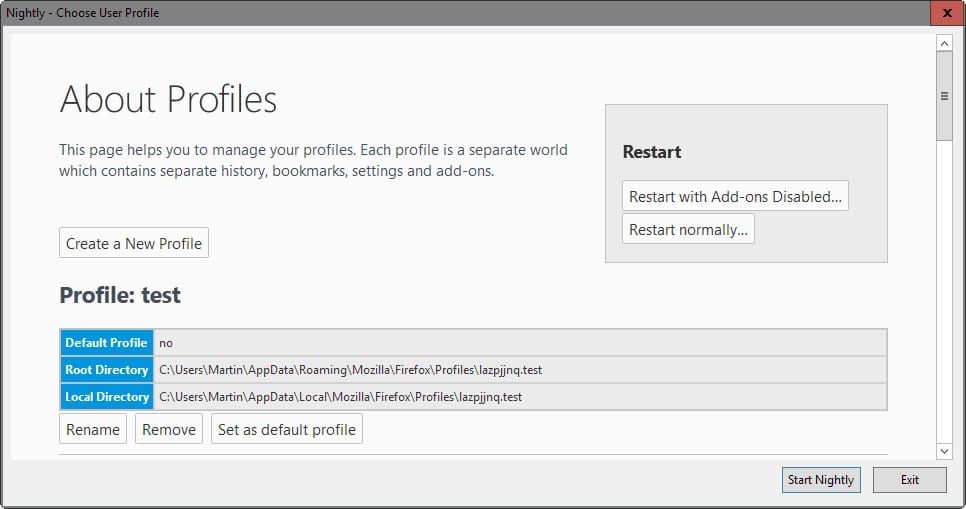

- FIREFOX PROFILE MANAGER WINDOWS HOW TO
- FIREFOX PROFILE MANAGER WINDOWS INSTALL
- FIREFOX PROFILE MANAGER WINDOWS WINDOWS
Scenario 2 - Multiple folder targets and replication Scenario 1 - Basic setup of geographically adjacent user stores and failover clusters High availability and disaster recovery with Profile Management Share Citrix user profiles on multiple file serversĪdminister profiles within and across OUsĭomain and forest support in Profile Management Review, test, and activate Profile Management Firefox saves your personal information such as bookmarks, addons, passwords, and user preferences in a set of files called your profile, which is stored in a separate location from the Firefox program files.Persistent? Provisioned? Dedicated? Shared?

You can have multiple Firefox profiles, each containing a separate set of user information. The Profile Manager allows you to create, remove, rename, and switch profiles. It is possible to take advantage of the Firefox Profiles feature in order to run multiple independent instances of the browser, each connecting to a different proxy. Mozilla Firefox now allows you to manage profiles while it’s running, without the need for using the Profile Manager found in older versions. The Profile Manager is not visible in the Firefox User Interface, running it will require typing commands into a terminal or using the Run Dialog for Windows. To access this feature, type about:profiles in Firefox’s address bar, and then press Enter. You can bookmark this page for easier access in the future, if you like. Access Firefox profile via Firefox browser. Starting the Profile Manager Importantīefore starting the Profile Manager, make sure that Firefox is completely closed. If the profile folder is not present in its default location, you can use this method to know its current location. Press Alt key on the keyboard to see Firefox menus.
FIREFOX PROFILE MANAGER WINDOWS WINDOWS
On Windows:, Press Windows Key + R, type firefox.exe -p into the Run dialog that appears, and press Enter Step 2: Click the Help menu and then click Troubleshooting Information option. Type /Applications/Firefox.app/Contents/MacOS/firefox-bin -profilemanager into the Terminal and press Enter On Mac: Open a Terminal window - press Command+Space, type Terminal, and press Enter to do it from Spotlight. On Linux: Open a terminal and run the firefox -P commandĪfter starting the Profile Manager, do the following to create a new profile:ġ. Click Create Profile, this will start the Create Profile WizardĢ. Give the profile any name you want Repeat the steps above for every profile that you need to create.ģ. Uncheck the box that says Use the selected profile without asking at startup to prevent Firefox from using the selected profile automatically.
FIREFOX PROFILE MANAGER WINDOWS INSTALL
Install the FoxyProxy addon in each profile Once you have set up the profiles you need, you’re almost good to go. First of all create a new firefox profile steps for it are 1.

Now you need to run the individual profiles and install the in each of them. Run this command firefox.exe -p in run window. It will show this dialog box create profile with new name and exit the window.
FIREFOX PROFILE MANAGER WINDOWS HOW TO
Will show you how to install FoxyProxy Firefox plugin. When Firefox is running and you try to open another Firefox process, a new window is opened instead, in the already running process. You can use the -no-remote command line option to start a new Firefox process that is invisible to the first process. The -no-remote command can be used from the terminal or you could modify an existing Firefox shortcut. The links below are articles that cover how to do the above in greater details:Īfter downloading and installing the FoxyProxy addon to each browser instance, configure each profile to use it’s own proxy.


 0 kommentar(er)
0 kommentar(er)
